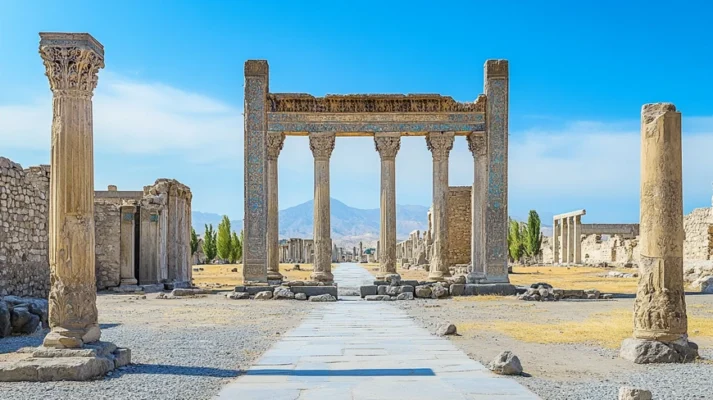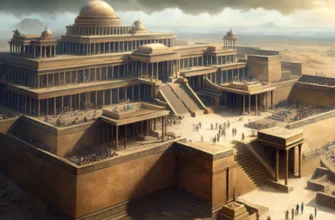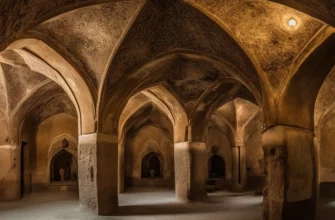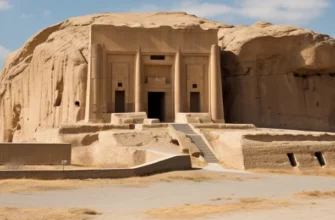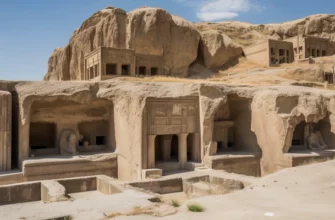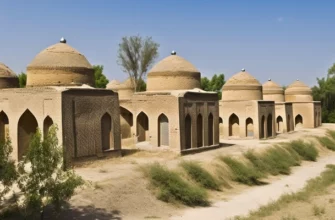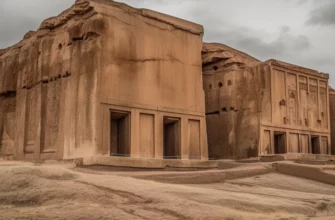Anshan is one of the oldest cities in modern Iran and played a key role in the formation of the Elamite and Persian civilizations.
Located in the southwestern part of the Iranian Plateau, in the region of the modern province of Fars, the city has been an important cultural and political center since the third millennium BC. During the Elamite Empire, Anshan was one of the main cities and later became the cradle of the Persian Empire.
It was here that Cyrus the Great, founder of the Achaemenid Empire, was born. In the 6th century BC, Anshan was integrated into the growing Persian Empire, becoming one of its important administrative and religious centers.
Archaeological research in Anshan has uncovered numerous clay tablets, palace ruins, and shrines, testifying to the high level of development of writing, architecture, and culture. The city was also strategically important due to its location on trade routes connecting Mesopotamia with Iran.
Anshan is not only an ancient city, but also a symbol of the beginning of the great Persian history. Its heritage continues to be studied by historians and archaeologists, revealing new pages of Iran’s past.
- History of Anshan
- Archaeological finds
- Anshan as part of the Persian Empire
- Connection with the Achaemenids
- Political significance of the city
- Art and architecture
- The art of Anshan
- Writing and language
- Elamite religion
- Religious practices and rituals
- Archaeological research
- Excavations in Anshan and their significance
- Conclusions
History of Anshan
The history of Anshan spans several millennia and is closely linked to the development of the Elamite and Persian civilizations. The first mention of Anshan dates back to the 3rd millennium BC, when the city became one of the main centers of Elam, an ancient state in southwestern Iran.
Elamite period
In the 2nd millennium BC, Anshan was the residence of the Elamite kings and an important religious center. Archaeological excavations have uncovered numerous cuneiform tablets that testify to a developed system of government, trade, and diplomatic relations with Mesopotamia.
Transition to Persian rule
Around the 7th century BC, Anshan fell under the rule of Persian tribes, among which the royal tribe of the Achaemenids stood out. It was here that Teisp, the father of Cyrus II the Great, ruled. Anshan became the nucleus from which the Persian Empire began to form. In 550 BC, Cyrus the Great, relying on the resources and influence of Anshan, overthrew the Median rule and founded one of the largest empires of the Ancient World.
The further fate of the city
After the formation of the Persian Empire, Anshan lost its leading political significance, giving way to new capitals — Pasargadae and later Persepolis. However, the city remained an important cultural and religious center for several centuries.
The Elamite civilization
During the heyday of Elam (c. 2700–640 BC), Anshan became one of the most important political and cultural centers of this ancient Iranian civilization.
The city served as the residence of kings and a key fortress in the struggle for power with other Elamite cities, particularly Susa. Thanks to its strategic location on the eastern border of Elam, Anshan played an important role in repelling attacks by nomadic tribes and maintaining ties with the interior regions of Iran.
Archaeological finds indicate that Anshan had a developed administrative system during this period. Clay tablets with Elamite cuneiform writing were produced here, and records of taxes, trade, and diplomatic agreements were kept. The city was also distinguished by its religious architecture — temples dedicated to the gods of the Elamite pantheon were centers of religious life.
In the late Elamite period, especially in the 12th–7th centuries BC, Anshan lost some of its political influence but remained an important cultural and religious center. It was at this time that Persian tribes began to grow in its territory, in particular the Achaemenids, who later used the city’s historical heritage to legitimize their power.
The role of Anshan in Elam
Anshan played a key role in the formation and development of the Elamite state as one of its oldest and most influential cities. Thanks to its geographical location on the border of the Zagros Mountains and the central Iranian plateau, the city served as an important center of control over trade routes and political influence in the region.
Throughout various periods of Elamite history, Anshan served as the main or alternative residence of the kings of Elam, competing for status with the city of Susa. In some inscriptions, Elamite rulers referred to themselves as “kings of Anshan and Susa,” which attests to the city’s level of authority.
In addition to its political significance, Anshan had cultural and religious importance. It was home to large temples dedicated to Elamite deities, including the goddess Pinikira. The city was also a center for the production of written documents, indicating a developed administrative system.
Anshan became a symbol of the Elamite heritage, which was later adopted by the Persians, especially the Achaemenid dynasty. Its role in the history of Elam is an example of how city-centers shaped entire civilizations through political power, religion, and culture.
Archaeological finds
Archaeological research in Anshan, particularly excavations in the Tal-e-Malian area (near modern Shiraz), has uncovered numerous pieces of evidence of the city’s high level of development during the Elamite era and the early Persian Empire.
The first large-scale excavations here were carried out in the 1970s by American and Iranian archaeologists, who identified the site as ancient Anshan.
Among the most significant finds are:
Clay tablets with Elamite and Akkadian cuneiform writing containing economic, administrative, and religious texts;
Cylindrical seals used to authenticate documents and property;
Fragments of palace and temple architecture, including foundation slabs, wall remains, and columns;
Pottery and metalwork, which testify to advanced craftsmanship and active trade.
Of particular value are inscriptions mentioning the name of Cyrus I (grandfather of Cyrus the Great) as ruler of Anshan, which help trace the genealogy of the Achaemenid dynasty and its roots in the Elamite tradition.
These discoveries confirm that Anshan was not only a political center, but also a cultural and administrative center with deep historical ties to both Mesopotamia and the interior of Iran.
Anshan as part of the Persian Empire
With the transition of Anshan to the rule of the Persian tribes in the 7th–6th centuries BC, the city became an important center for the emergence of the future Persian Empire.
One of the first rulers of Persian origin to rule Anshan was Teisp, founder of the Achaemenid dynasty. It was his son, Cyrus II the Great, who rose from Anshan in the middle of the 6th century BC to usher in a new era in the history of the Ancient East.
Anshan played a dual role: as a symbol of the legitimacy of the Achaemenid dynasty (which was linked to the Elamite heritage) and as a base for the expansion of the new state. Cyrus II called himself “King of Anshan” even before the conquest of Media and the creation of the empire, which testifies to the high political significance of the city even during the formation of Persian power.
After the formation of the Persian Empire, Anshan gradually lost its strategic importance in favor of the new capitals, Pasargadae and Persepolis, but remained an important religious and cultural center. The Achaemenids maintained ties with the Elamite heritage through architecture, writing, and rituals, partially preserving rituals that originated during the Elamite period.
Thus, Anshan became a bridge between two great cultures — the Elamite and Persian — and played a decisive role in the formation of the first global empire in history.
Connection with the Achaemenids
Anshan had direct and symbolic significance for the Achaemenid dynasty, as it was the birthplace of the empire’s founder, Cyrus II the Great.
His father, Teisp, was the ruler of Anshan, which indicates the importance of this city in shaping the tribal identity of the future Persian dynasty. Anshan was the center of the Persian tribes, and later this city became an important political center from which the path to the creation of one of the largest empires in the ancient world began.
Cyrus the Great, who came to power in the middle of the 6th century BC, proclaimed himself “King of Anshan” even before he made his famous conquests, which led to the unification of Persia, Media, Lydia, and Babylonia into a single empire.
This title emphasized the city’s importance in the formation of the Achaemenid Empire and its cultural and political heritage. Anshan’s connection to the Achaemenids was not limited to the title. Persian monarchs actively used the Elamite heritage in political, religious, and cultural matters.
Achaemenid palaces and temples often featured elements reminiscent of Elamite architectural style and used Elamite script for inscriptions on monuments. This demonstrates the recognition of Elamite culture as an important part of the history of the Persian people.
Anshan also became a center of religious and administrative importance for the Achaemenids, where rituals and cultural practices that preserved traditions dating back to Elamite times were carried out.
Political significance of the city
Anshan was of great political importance, extending beyond its territory and influencing broader processes in the history of Iran and the Middle East.
From its founding, the city became an important administrative and strategic center of Elamite civilization and later the base for the expansion of the Persian tribes, which eventually became the foundation for the vast Persian Empire.
As the center of Elamite politics
During the Elamite period, Anshan was one of the main political centers where the Elamite kings ruled. Connections with other cities, such as Susa, allowed Anshan to be an important part of the complex political network of Elam. Its role in international politics was significant — the city was a key commercial, diplomatic, and cultural center.
The Achaemenid Empire
When the Persian tribes began to conquer the territories of Elam in the 7th century BC, Anshan became an important base for the ruling Achaemenid dynasty.
The title “King of Anshan” was used by Cyrus the Great to legitimize his power even before he began his conquest of Media, Lydia, and Babylonia. This indicates that Anshan was not only geographically important but also a symbolically respected center.
Administrative center
As part of the Persian Empire, Anshan gradually lost its importance as the main capital, as new administrative centers such as Pasargadae and Persepolis became the main seats of power. However, it remained an important city on the eastern border of the empire, especially for controlling neighboring tribes and maintaining internal peace.
Anshan as a political symbol
Despite the change of capitals, Anshan retained its political significance thanks to its deep ties to the Elamite past and traditions. The city became a symbol of Persian heritage and political legitimacy, and even after the fall of the Achaemenids, it remained an important cultural center for subsequent Iranian states.
Art and architecture
The art and architecture of Anshan were closely linked to the Elamite and Persian cultural heritage. The city became an important center for the development of architectural styles and artistic traditions that ultimately influenced the further development of Persian civilization. The discovery of numerous archaeological sites in the city allows us to see how Elamite art and architecture evolved, paving the way for the rise of the Persian Empire.
Architecture of the Elamite period
The architecture of Anshan during the Elamite period was characterized by simplicity and functionality. The remains of palaces, temples, and fortresses discovered during excavations testify to the use of local building materials such as brick and stone, as well as the presence of complex structures and fortifications. In particular, the remains of buildings with large open courtyards have been found, indicating a developed planning tradition and strong defensive structures.
Of particular interest are the numerous reliefs and bas-reliefs that adorned temples and palaces, depicting religious scenes, military exploits, and royal portraits. This was an important part of Elamite culture, where art had not only a decorative but also a sacred function.
The influence of the Achaemenids on architecture
Over time, when the Achaemenids took control of Anshan, the city’s architecture began to transform under the influence of Persian traditions. The palaces and temples built by the Achaemenids were characterized by grandeur and monumentality, as well as the integration of Elamite elements into the overall architectural style. Thus, large stone platforms, massive walls, numerous columns, and bas-reliefs depicting scenes from the lives of Persian kings, as well as divine symbols combining the Persian religion with Elamite beliefs, appeared.
Particularly famous is the palace in Pasargadae, where architectural elements derived from the traditions of Anshan are clearly visible, particularly in the design of the columns and capitals.
The art of Anshan
The art of Anshan included various forms, such as pottery, metallurgy, and jewelry. One of the main features of Elamite art was the use of bright colors in ceramics and pottery. Unique ceramic vases and pots with intricate ornamentation, as well as metal jewelry and cylindrical seals, became an important element of Elamite culture.
Persian masters, who adopted the traditions of Anshan, created equally impressive jewelry, including gold, silver, and gemstone jewelry. However, with the introduction of Persian art, much more attention was paid to depicting monarchs and their achievements, both in sculpture and painting.
Impact on later architecture
The architectural and artistic elements that emerged in Anshan had a huge influence on later Persian architecture and art. This is evident in Persepolis, the capital of the Achaemenid Empire, where one can see the continuity of forms and stylistic solutions that were characteristic of Anshan.
Writing and language
The writing and language of Anshan played an important role in the development of both the Elamite civilization and the integration of this culture into broader cultural and political contexts, particularly during the Achaemenid period. Archaeological finds from Anshan provide insight into Elamite writing and its influence on later Persian administrative practices.
Elamite writing
The main form of writing in Anshan was Elamite cuneiform. It is a writing system that used cells to record the Elamite language, one of the oldest languages in Iran. Elamite writing originated in the third millennium BC and existed until the Persian Empire, although it was gradually replaced by other writing systems.
This writing system was used for various purposes, including administrative records, diplomatic agreements, and recording important events. One of the important archaeological finds are clay tablets containing Elamite texts, which confirm the high level of organization and documentation in society.
Persian and Akkadian languages
With the arrival of the Persian rulers, especially with the rise of the Achaemenid dynasty, the Elamite language and writing were gradually replaced by the Persian language in its ancient form.
Persian became the language of government, the official language of state documents and international agreements. During this period, Akkadian cuneiform, which was widespread in Mesopotamia, was also actively used and became an important language of diplomacy and trade in the region.
During the Achaemenid rule, the Elamite script and language did not disappear completely. They continued to be used for some religious and administrative purposes and were even preserved in some texts describing the activities of the Persian monarchs.
Inscriptions found on Achaemenid monuments, such as the reliefs at Persepolis, often combined Persian and Elamite writing, indicating the preservation of the Elamite cultural heritage in the new empire. Writing was of great importance for the organization and administration of the Persian Empire, which covered vast territories.
Persian kings used it to conduct state affairs, conclude treaties, and write royal decrees, reflecting the high level of development of the administrative system. Moreover, it became an important tool for preserving and transmitting religious and cultural values, contributing to the unity of the multinational empire.
Religion and beliefs
Religion and beliefs in Anshan and within the Elamite civilization had a profound influence on cultural and social aspects of life. Over time, the religious practices of Anshan evolved, reflecting changes in the political system and influences from other civilizations, particularly Mesopotamia and Persia.
Religion in this region was polytheistic and included the worship of numerous deities that symbolized various natural forces, phenomena, and social aspects.
Elamite religion
The Elamite religion was based on beliefs in numerous deities covering aspects such as fertility, nature, war, and city protection.
Among the most famous deities of the Elamites were:
Pinnikur — the chief deity of Anshan and Elam, the deity of fertility and the earth. Her cult was central to religious practice, and large temples were dedicated to her, where sacrifices and rituals were performed.
Shamash — the god of the sun and justice, also popular in Mesopotamia. He was associated with justice and protection, and his cult was widespread in Elam.
Ishtar — the goddess of love, war, and fertility, whose cult was widespread in Mesopotamia and Elam. Ishtar was depicted as a beautiful woman who could both give life and destroy it through her aggressiveness.
The gods worshipped by the Elamites were often depicted as human figures, birds, or animals, which had a deep symbolic meaning. Such images were often used on reliefs and bas-reliefs that decorated temples and palaces.
Religious practices and rituals
Religious rituals in Anshan included numerous celebrations, sacrifices, and ritual dances performed in honor of the gods to ensure their favor. Believers often sacrificed animals, particularly sheep and bulls, as well as gifts of pottery and precious metals. Priests and priestesses played an important role in religious life, ensuring that rituals were performed correctly and maintaining the connection between humans and the gods.
Influence of Persian religion
When the Persians rose to power in Anshan, they began to integrate the religious beliefs of the Elamites into their own religion. The Persian religion, which later developed into Zoroastrianism, retained many aspects of Elamite beliefs.
Although Zoroastrianism became the dominant religion of the Persian Empire, elements of the Elamite religious experience could still be found in the religious practices of the Persians, particularly in their worship of natural forces and the importance of rituals.
Zoroastrianism, however, unified religious beliefs and provided a new organized structure for the worship of gods such as Ahura Mazda, the supreme god symbolizing good and light. Although Persian monarchs often supported the cults of local deities, they still gave preference to Zoroastrianism as the state religion.
Gods and places of worship
Anshan was also home to numerous places of worship. The most famous of these is the temple dedicated to Pinikir, where annual religious festivals and sacrifices were held.
Archaeological remains of temples and shrines found there indicate that religion played a central role in the social and political life of the city.
Archaeological research
Archaeological research in Anshan plays a key role in studying the history of the Elamite civilization and its influence on the further development of the Persian Empire. Thanks to numerous excavations carried out in the ancient city and its surroundings, numerous artifacts have been found that help to understand the social, economic, and religious structure of this important region.
First excavations
The first wave of archaeological research in Anshan began in the late 19th century. However, most of the discoveries were made in the mid-20th century, when archaeologists from various countries, including Iran, France, and the United States, began to systematically explore the ruins of the ancient city. One of the main centers of research was the tell, a large artificial mound formed by deposits that had accumulated over thousands of years.
Major archaeological finds
Temples and palaces: During excavations in Anshan, the remains of several large temples and palaces belonging to the Elamite kings were discovered. This provides insight into the architectural traditions of Elamite culture, as well as the functional purpose of individual buildings.
For example, temples have been discovered where altars and other religious artifacts have been preserved, testifying to the importance of religious practices in the life of the city.
Reliefs and bas-reliefs: Numerous reliefs depicting scenes of religious rituals, military achievements, and royal figures have been found on the walls of some buildings.
These artifacts are valuable for studying Elamite culture because they provide information about what gods, kings, and ordinary people looked like in that society. Clay tablets and inscriptions: One of the important finds is numerous clay tablets containing Elamite inscriptions.
These texts usually deal with administrative or religious matters, including records of taxes, agreements, and rituals. They provide insight into the organization of Elamite society, its interaction with neighboring cultures, and the preservation of writing over the centuries.
Jewelry and pottery: Archaeologists have found numerous pieces of jewelry, ceramic vessels, and other artifacts that testify to the high skill of local craftsmen. Various ornaments made of gold, silver, copper, as well as ceramics with characteristic ornaments, tell us about the aesthetic tastes and social structures of Elamite society.
Excavations in Anshan and their significance
Excavations in Anshan continue to be an important source of knowledge about ancient Iran and, in particular, the Elamite civilization.
Thanks to them, it has been possible to reconstruct many aspects of life in this region, from religious rituals to socio-political structures. In particular, these studies provide a better understanding of Anshan’s links with other great civilizations of the time, such as Mesopotamia, and show how the Elamites interacted with neighboring cultures.
Contemporary research
Contemporary archaeological research in Anshan continues, and every year new discoveries are made that allow us to deepen our knowledge of this ancient center. One of the latest achievements is the use of cutting-edge technologies, such as ground-penetrating radar and remote sensing, to study underground structures and identify new archaeological sites without the need for large-scale excavations.
Conclusions
Anshan played a key role in the formation and development of ancient Iranian civilization, becoming an important cultural, political, and religious center. Its strategic location, rich natural resources, and close ties with other civilizations of the Middle East determined its importance in the history of Iran and Mesopotamia. As the center of Elam, Anshan became the foundation for the creation of the powerful Achaemenid Empire, which united vast territories and peoples under a single rule. It also became an important center of the Elamite religion, particularly the worship of fertility deities and natural forces.
The religious practices and beliefs of Anshan eventually became part of the Persian religious system, influencing the development of Zoroastrianism in particular. Archaeological research in Anshan has uncovered numerous artifacts that give us insight into the social, economic, and religious aspects of life in this city.
The discovery of temples, palaces, reliefs, and written sources has helped reconstruct many aspects of Elamite civilization and demonstrated the importance of this city in the context of the Middle East. During the Achaemenid period, Anshan retained many elements of Elamite culture, and its influence was evident not only in architecture and art but also in political and administrative practices that drew on the experience of Elamite civilization.
Anshan remains one of the most important archaeological and historical sites, continuing to provide important information about the stages of the formation of Iran’s great civilization and its influence on neighboring peoples and cultures.
